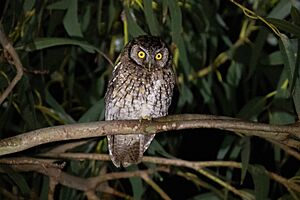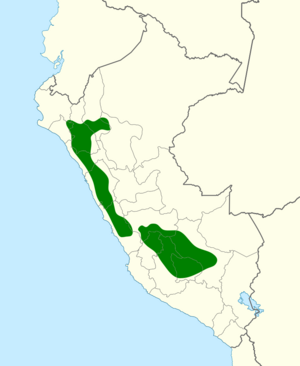Koepcke's screech owl facts for kids
Quick facts for kids Koepcke's screech owl |
|
|---|---|
 |
|
| Conservation status | |
| Scientific classification | |
| Genus: |
Megascops
|
| Species: |
koepckeae
|
 |
|
| Synonyms | |
|
Otus choliba koepckeae Hekstra, 1982 |
|
The Koepcke's screech owl (Megascops koepckeae) is a type of owl. It belongs to the Strigidae family, which includes many well-known owls. This special owl lives only in Peru.
Contents
About Koepcke's Screech Owl
What's in a Name?
Koepcke's screech owl was first thought to be a type of tropical screech owl. Scientists now consider them to be "sister species," meaning they are very closely related. This owl was named after Maria Koepcke. She was a German bird expert who did a lot of research in Peru.
Different Types of Koepcke's Screech Owls
There are two main groups, or subspecies, of Koepcke's screech owl. These are M. k. koepckeae and M. k. hockingi.
Appearance and Size
How Big Are They?
Koepcke's screech owls are about 24 cm (9.4 in) long. That's about the length of a ruler!
What Do They Look Like?
The M. k. koepckeae subspecies has a whitish-gray face with darker spots. It has short, whitish "eyebrows" above its bright yellow eyes. Its head is very dark brown with light brown speckles.
The upper part of its body is grayish-brown to dark brown. It has dark streaks and bars. When its wings are folded, you can see a line of whitish spots. Its tail is dark brown with thin, light brown bars and small speckles.
The owl's belly is grayish-white. It has wide, dark brown streaks and uneven bars. The upper chest has a light brownish-orange tint.
Differences Between Subspecies
The M. k. hockingi subspecies looks similar to M. k. koepckeae. However, it is generally grayer. The markings on its belly are also less noticeable.
Where Koepcke's Screech Owls Live
Their Home in Peru
Koepcke's screech owl is found only in Peru. The two subspecies live in different parts of the country.
The M. k. koepckeae subspecies lives in northern Peru. You can find it in areas like Lambayeque, Cajamarca, and La Libertad. It also lives in the valley of the Utcubamba River. Some small areas in Ancash and Lima also have them.
The M. k. hockingi subspecies lives further south. It is found in places like Junín, Huancavelica, Ayacucho, and Apurímac.
Their Habitats
These two owl groups prefer different types of places to live. The M. k. koepckeae subspecies lives in evergreen forests. These forests are found at high elevations, between 1,840 and 4,500 m (6,040 and 14,760 ft).
On the other hand, M. k. hockingi lives in dry forests. It also likes scrubby areas in valleys between mountains. It is usually found at elevations between 1,400 and 3,400 m (4,600 and 11,200 ft). Most often, you'll find it below 2,000 m (6,600 ft).
Koepcke's Screech Owl Behavior
What Do They Eat?
Like most screech owls, Koepcke's screech owl is active at night. Scientists haven't studied their diet much. However, it seems they mostly eat insects. They might also eat small vertebrates, like tiny animals with backbones.
Reproduction and Nests
Not much is known about how Koepcke's screech owls raise their young. In south-central Peru, they breed in February and March. Most owls of this type nest in holes in trees. However, one nest was found in a hole in an earthen bank.
What Do They Sound Like?
The song of a Koepcke's screech owl is loud and sharp. It starts with notes that get slower and louder: ko-ko-ko-ko ka ka KA KAH!. The M. k. hockingi subspecies has a similar song, but it's longer and higher-pitched.
When they are feeling aggressive, they make quieter, short hoots. These hoots rise and fall in pitch. Sometimes, a pair of owls will sing together in a duet.
Conservation Status
The IUCN (International Union for Conservation of Nature) has listed Koepcke's screech owl as a species of "Least Concern." This means they are not currently considered to be in danger.
Even though we don't know the exact number of these owls, their population seems to be stable. They can even live well in areas where their habitat has changed. This is true as long as some trees are left for them to nest and rest in.


